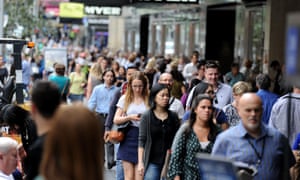Full-time employment falls by 20,000 but is offset by larger rise in part-time work
Australia’s unemployment rate has fallen to a six-month low in May –
but the new jobs being created in the economy are overwhelmingly
part-time in nature.
Full-time jobs fell by 20,600 during the month, and part-time jobs rose by 32,600, leaving a net improvement of 12,000 positions, while the monthly hours worked in all jobs decreased, by 1.4%.
The overall unemployment rate fell to 5.4%, down from a figure of 5.6% in April.
Economists say the figures are disappointing and the improvement in the unemployment rate is not what it seems. They say the unemployment rate declined because the participation rate eroded.
In trend terms, which smoothes the volatility in seasonally adjusted figures, the unemployment rate held steady at 5.5%, where it has sat since August 2017.
Malcolm Turnbull welcomed the news, saying the fall in the unemployment rate and the small lift in jobs shows the Coalition’s policies are job-creating.
“Jobs and growth is what we said in 2016 and we’re delivering on it, because we have got the policies that are building a stronger economy,” he said on Thursday.
But economists say a closer look at the figures shows the decline in the unemployment rate occurred because the labour force actually declined by 14,800 persons.
The “labour force” is defined as the number of persons who are either employed or unemployed but actively looking for work. If an unemployed person stops looking for work altogether, they will drop out of the official “labour force” and the labour force will shrink.
The labour force declined in May, in seasonally adjusted terms, from 13,247,700 persons to 13,232,900 persons.
That means the participation rate – which is the “labour force” expressed as a percentage of the working population aged 15 years and over – also declined, by 0.1 points to 65.5%. The participation rate is now 0.3 points off its January high of 65.8%.
Data shows the pace of annual jobs growth has also slowed to 2.5% –the slowest rate since July last year.
The “underemployment rate” (tracking those who are employed but who want more work) has also increased slightly, by 0.1 points to 8.5%, and the underutilisation rate (unemployed persons + underemployed persons) is still sitting at 13.9%.
Kate Hickie from Capital Economics said: “Overall, even if the pace of job creation picks up again in the coming months, this excess slack and other structural forces are likely to prevent wage growth from increasing much above its current rate of 2.1% this year. In fact, we suspect it will remain below 2.5% throughout this year and next.”
Reserve Bank governor Philip Lowe told a business audience in Melbourne this week that the RBA was still trying to figure out why countries such as Australia were not experiencing the traditional increase in wages growth in response to tightening labour markets.
Full-time jobs fell by 20,600 during the month, and part-time jobs rose by 32,600, leaving a net improvement of 12,000 positions, while the monthly hours worked in all jobs decreased, by 1.4%.
The overall unemployment rate fell to 5.4%, down from a figure of 5.6% in April.
Economists say the figures are disappointing and the improvement in the unemployment rate is not what it seems. They say the unemployment rate declined because the participation rate eroded.
In trend terms, which smoothes the volatility in seasonally adjusted figures, the unemployment rate held steady at 5.5%, where it has sat since August 2017.
Malcolm Turnbull welcomed the news, saying the fall in the unemployment rate and the small lift in jobs shows the Coalition’s policies are job-creating.
“Jobs and growth is what we said in 2016 and we’re delivering on it, because we have got the policies that are building a stronger economy,” he said on Thursday.
But economists say a closer look at the figures shows the decline in the unemployment rate occurred because the labour force actually declined by 14,800 persons.
The “labour force” is defined as the number of persons who are either employed or unemployed but actively looking for work. If an unemployed person stops looking for work altogether, they will drop out of the official “labour force” and the labour force will shrink.
The labour force declined in May, in seasonally adjusted terms, from 13,247,700 persons to 13,232,900 persons.
That means the participation rate – which is the “labour force” expressed as a percentage of the working population aged 15 years and over – also declined, by 0.1 points to 65.5%. The participation rate is now 0.3 points off its January high of 65.8%.
Data shows the pace of annual jobs growth has also slowed to 2.5% –the slowest rate since July last year.
The “underemployment rate” (tracking those who are employed but who want more work) has also increased slightly, by 0.1 points to 8.5%, and the underutilisation rate (unemployed persons + underemployed persons) is still sitting at 13.9%.
Kate Hickie from Capital Economics said: “Overall, even if the pace of job creation picks up again in the coming months, this excess slack and other structural forces are likely to prevent wage growth from increasing much above its current rate of 2.1% this year. In fact, we suspect it will remain below 2.5% throughout this year and next.”
Reserve Bank governor Philip Lowe told a business audience in Melbourne this week that the RBA was still trying to figure out why countries such as Australia were not experiencing the traditional increase in wages growth in response to tightening labour markets.

No comments:
Post a Comment